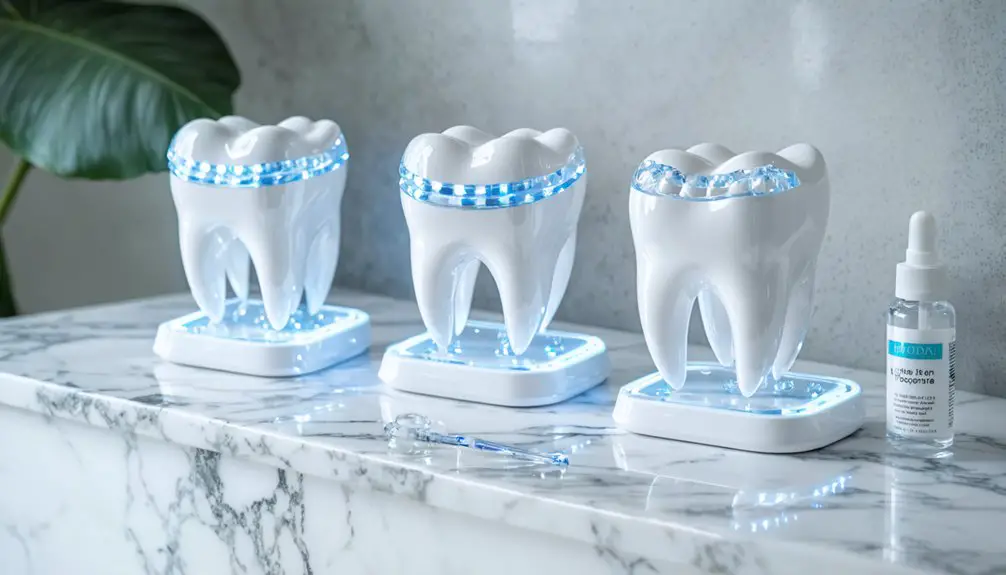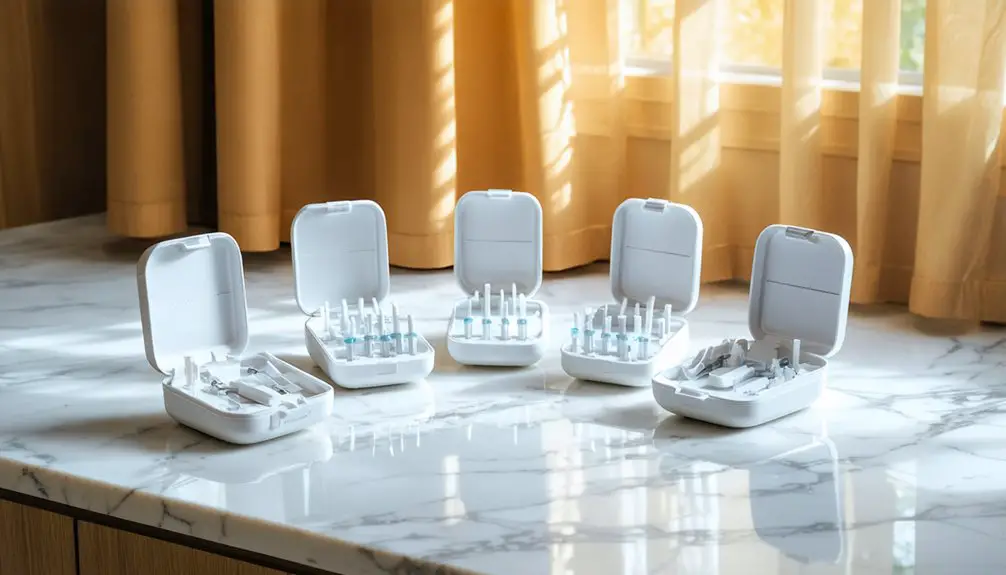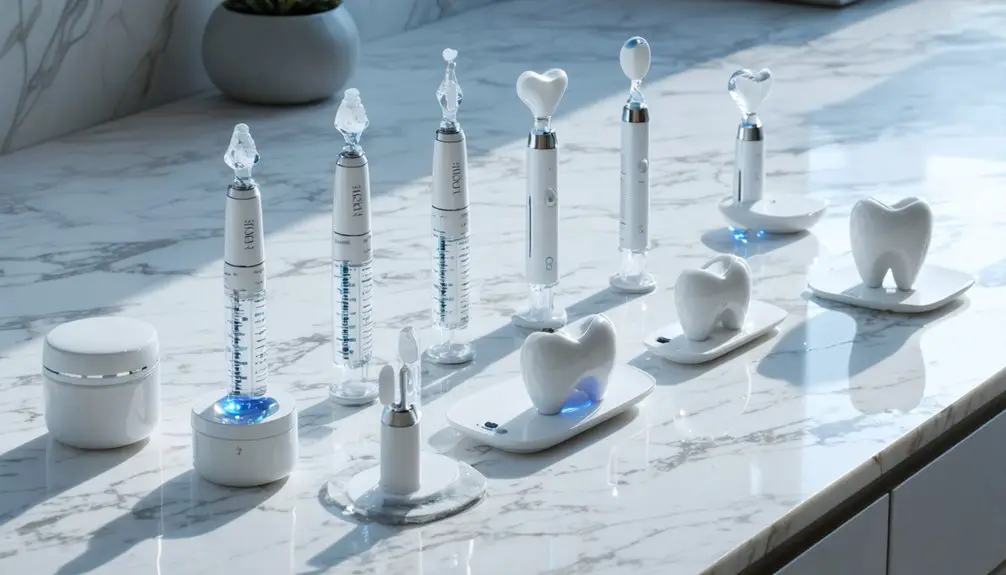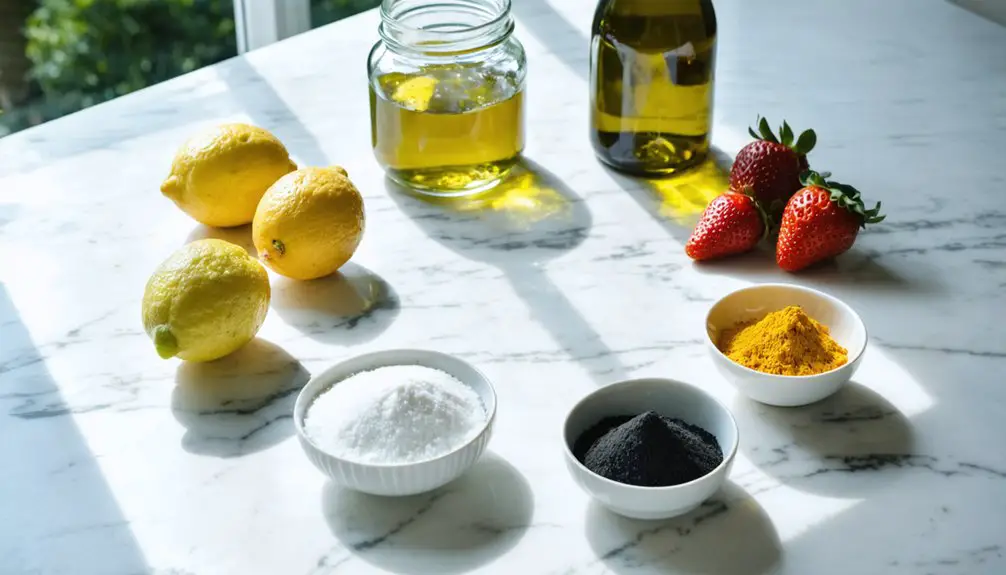You’ll find the most effective DIY teeth whitening options in 2025’s top-rated kits. Crest 3D Whitestrips Professional Express leads the market with its LED system and proven 2.6-shade improvement in 19 days. Opalescence Go offers convenient pre-filled trays, while Snow Teeth Whitening Kit provides gentle results for sensitive teeth. For custom-fitted precision, consider Smile Brilliant, or try budget-friendly Auraglow. Understanding each kit’s unique features will help you choose the perfect match for your whitening goals.
Key Takeaways
- Crest 3D Whitestrips Professional Express delivers up to 2.6 shades improvement in 19 days with LED technology and minimal gum irritation.
- Opalescence Go provides consistent whitening results with pre-filled trays, though some users may experience tooth sensitivity.
- Snow Teeth Whitening Kit uses specialized LED technology and is particularly suitable for users with sensitive teeth.
- Smile Brilliant offers custom-fitted trays for precise application and professional-level results through personalized impressions.
- Auraglow provides a budget-friendly option that balances effectiveness with sensitivity management while offering varying treatment durations.
Top-Rated DIY Teeth Whitening Products for 2025
Five leading DIY teeth whitening kits have emerged as top contenders for 2025, each offering unique advantages for different user needs.
Crest 3D Whitestrips Professional Express stands out with its LED light system, delivering up to 2.6 shades of improvement within 19 days. The system achieved 100% tester satisfaction for removing surface stains without causing gum irritation. User experiences indicate Opalescence Go’s pre-filled trays provide consistent results, though sensitivity may occur. Most comprehensive kits cost between $50-$300 for effective at-home treatment.
LED-powered Crest 3D Whitestrips achieve notable whitening results within weeks, while Opalescence Go offers reliable outcomes despite potential tooth sensitivity.
The Snow Teeth Whitening Kit offers reduced irritation with its specialized LED technology. Product comparisons show Smile Brilliant’s custom-fitted trays excel in precision application, minimizing gel leakage through personalized impressions.
For budget-conscious users, Auraglow delivers gradual but noticeable results at a lower price point. Each kit balances effectiveness with varying levels of sensitivity management, treatment duration, and application methods to suit your specific whitening goals.
Understanding Whitening Ingredients and Their Effects
When selecting a DIY teeth whitening product, understanding the active ingredients and their effects on your dental health is essential.
Most products contain hydrogen peroxide or carbamide peroxide as their primary whitening agents, which break down stain molecules through the release of reactive oxygen species. EU regulations limit over-the-counter whitening products to 0.1% hydrogen peroxide.
While these agents effectively whiten teeth, they can affect enamel integrity if used improperly. Lower concentration peroxide products used at home may actually cause more demineralization over time compared to professional treatments. Among over-the-counter options, whitening strips have shown the most reliable bleaching efficacy.
You’ll find many products also contain abrasives like hydrated silica or sodium bicarbonate, which primarily target surface stains. These ingredients are generally safe when used as directed, though they won’t address deeper, intrinsic staining.
For ideal results and dental safety, choose products with clinically validated ingredients and follow application instructions carefully.
How Different Whitening Technologies Work
Modern teeth whitening technologies employ distinct mechanisms to achieve dental brightening, from peroxide-based chemical reactions to advanced light-activation systems.
You’ll find hydrogen peroxide as the primary active ingredient, with concentrations ranging from 10% in over-the-counter kits to 44% in professional laser treatments.
The whitening process occurs through oxidation, where peroxide breaks down stain molecules in your teeth.
LED systems accelerate this process using blue light without generating excess heat, while laser treatments deliver more dramatic results with higher peroxide concentrations. Both laser and Zoom whitening can lighten teeth considerably, achieving up to eight shades of improvement.
Some systems, like KöR, use specialized gel formulations with stabilizing agents to enhance effectiveness. Professional treatments often require gum protection measures to prevent tissue irritation during the whitening process.
When choosing a whitening technology, you’ll need to evaluate the trade-off between treatment speed and sensitivity risk, as higher peroxide concentrations work faster but may cause more tooth sensitivity.
Comparing Treatment Times and Results
You’ll find significant variation in treatment times across DIY whitening kits, from quick 5-minute sessions with Plus White to 19-day regimens with Crest 3D Whitestrips Professional Express.
LED-assisted systems like Snow and GLO Brilliant can deliver visible results within a week, while gentler PAP-based or natural alternatives require several weeks of consistent use.
Professional dentists recommend whitening only after ensuring teeth are free of cavities and disease to prevent complications. While stronger peroxide concentrations work faster, you’ll need to carefully balance treatment intensity against tooth sensitivity and maintain results through periodic touch-up sessions. A thorough dental cleaning beforehand helps maximize the effectiveness of any at-home whitening treatment.
Short Vs Long Treatments
Choosing between short and long-term teeth whitening treatments requires careful consideration of your goals, time commitment, and sensitivity concerns.
Short treatments, like professional in-office sessions, use higher concentrations of whitening agents (25-40% hydrogen peroxide) and can lighten teeth up to 8 shades in just one to two hours. However, they may cause increased sensitivity and require professional supervision.
Long treatments, such as at-home kits, use lower concentrations for gentler whitening over 7-14 days. While they take more time to show results, they’re typically more comfortable and can achieve up to 16 shades lighter when combined with professional care. People over thirty may need more frequent touch-ups since aging affects whitening results. You’ll need to maintain a consistent routine, but the gradual approach often leads to more stable, longer-lasting results with fewer sensitivity issues.
The flexibility of at-home treatments allows you to whiten your teeth around your daily schedule without requiring dental office visits.
Expected Results Timeline
Understanding the timeline for teeth whitening results helps set realistic expectations for your treatment journey.
You’ll likely notice initial changes within the first few days of treatment, though dramatic results aren’t immediate.
For professional take-home kits, you can expect ideal whitening within 10-14 days of consistent use. Over-the-counter products typically require 2-4 weeks to achieve maximum results.
Your expected results will vary based on several factors, including initial tooth color, stain type, and treatment concentration.
The most significant whitening occurs during the first two weeks, followed by gradual improvements until reaching a plateau. Your whitening expectations should account for this pattern.
Remember that maintaining your results requires good oral hygiene and periodic touch-ups, typically every 6-12 months, depending on your lifestyle habits.
Maintenance Between Sessions
Maintaining your whitening results requires a structured approach that balances treatment frequency with safety considerations.
Most maintenance kits recommend monthly touch-ups of about 15 minutes, though you’ll need to adjust based on your specific product’s guidelines. For best results, make sure you’re spacing treatments at least 24 hours apart.
When applying gel, use only ¼ to 1/5 cc per tooth to prevent sensitivity while maximizing effectiveness.
You’ll want to clean your teeth thoroughly before each session, as moisture and residue can reduce the gel’s performance.
For long-term success, plan your maintenance schedule every 3-6 months, depending on your lifestyle habits and product instructions.
Remember not to exceed 14 consecutive days of treatment, as this could potentially damage your enamel.
Managing Sensitivity and Side Effects
To minimize tooth discomfort during DIY whitening, you’ll need to follow product instructions carefully and consider using a desensitizing toothpaste before starting treatment.
You can prevent gum irritation by ensuring the whitening gel stays away from your gum line and using custom-fitted trays when possible.
If you experience persistent sensitivity or gum problems, you should discontinue use immediately and consult your dentist for professional guidance.
Minimizing Tooth Discomfort
While teeth whitening can effectively brighten your smile, it often leads to temporary sensitivity and discomfort that requires careful management. Start using desensitizing toothpaste 1-2 weeks before treatment and apply sensitivity gels as directed to block nerve signals and reduce pain.
You’ll want to implement these proven strategies to minimize discomfort:
- Take over-the-counter pain relievers 30 minutes before treatment and choose whitening products with lower peroxide concentrations (6-10%).
- Reduce frequency to every other day if sensitivity develops, and limit treatment duration to the shortest effective time.
- Avoid hot and cold foods for 48 hours post-treatment, using a straw for beverages to prevent direct contact with sensitive areas.
Preventing Gum Irritation
Protecting your gums from irritation during DIY teeth whitening requires careful attention to product selection and application technique. Before starting any whitening regimen, consult your dentist to assess your gum sensitivity and receive guidance on safe whitening practices.
To implement effective gum protection strategies, use custom-fit trays that prevent gel leakage, and apply a protective barrier like petroleum jelly along your gum line. Carefully follow the manufacturer’s timing instructions, and don’t exceed recommended treatment frequency.
If you notice burning sensations, redness, or white patches on your gums, immediately rinse and discontinue use.
Pre-treat your gums with sensitive toothpaste and avoid acidic foods during whitening periods. Remember that professional whitening procedures offer more controlled peroxide concentrations and better gum protection than DIY options.
Cost Analysis of Popular Whitening Systems
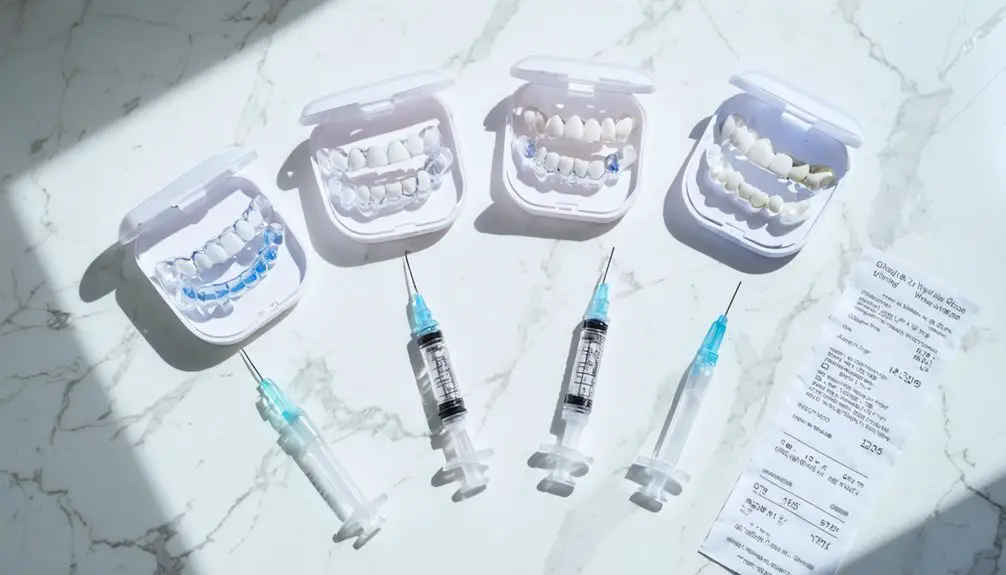
Before choosing a teeth whitening system, understanding the cost differences between over-the-counter and professional options can help you make an informed decision. OTC pricing ranges from $5 to $60, with whitening strips averaging $34 and ready-made kits around $35.
Smart shoppers compare teeth whitening costs, with OTC options starting at $5 while professional solutions offer stronger, supervised treatment for lasting results.
Professional costs for take-home kits typically run between $150 to $600, including custom-fitted trays and dental supervision.
Consider these key factors when evaluating whitening systems:
- Professional kits offer stronger whitening agents and custom trays, delivering faster, more uniform results.
- OTC products provide affordability but require longer treatment times and may need frequent repurchasing.
- While professional options have higher upfront costs, they often prove more cost-effective due to longer-lasting results and reduced sensitivity risks.
Matching Kits to Your Whitening Goals
Selecting the right whitening kit depends on your specific goals and oral health needs. For ideal whitening goals alignment, consider the type and depth of your tooth stains. Surface stains from beverages respond well to hydrogen peroxide strips with LED light, while deeper discolorations require stronger carbamide peroxide formulations.
Key kit selection tips include evaluating your sensitivity level. If you’ve experienced tooth sensitivity, choose gentler options like PAP-based or sodium bicarbonate products.
For quick results, LED-assisted kits can accelerate whitening within a week. However, if you’re looking to maintain previous whitening results or address mild staining, standard peroxide strips used consistently over time will suffice.
Remember that professional treatments remain the most effective for severe staining, while DIY kits work best for gradual improvement.
Frequently Asked Questions
Can I Whiten My Teeth While Wearing Braces or Dental Crowns?
You’ll create a colorful patchwork if you attempt braces whitening or crown maintenance now. Wait until your braces come off, since whitening only works on natural teeth, not orthodontic hardware or crowns.
How Long Do Teeth Whitening Results Typically Last?
Your teeth whitening duration typically lasts 6 months to 2 years, but factors affecting longevity include your consumption of staining foods, oral hygiene habits, and whether you maintain with periodic touch-ups.
Is It Safe to Whiten Teeth While Pregnant or Breastfeeding?
Prioritize postponing professional whitening methods during pregnancy or breastfeeding. While there’s no conclusive evidence of harm, you’ll want to wait until after nursing to guarantee your baby’s complete safety.
Can Children or Teenagers Use Teeth Whitening Kits?
You shouldn’t use whitening kits before age 15 due to age restrictions and safety concerns. Consult your dentist first, as professional dental advice is essential for protecting developing teeth.
Should I Whiten My Teeth Before or After Getting Dental Work Done?
Like getting dressed before a portrait, you’ll want to whiten before dental work. Timing considerations and dental advice strongly suggest this sequence to guarantee restorations match your desired tooth shade perfectly.
References
- https://www.goodhousekeeping.com/health-products/g28723133/best-at-home-teeth-whitening-products/
- https://g-p-dental.com/best-teeth-whitening-kits-in-2025-safe-option/
- https://deandentalsolutions.com/the-best-at-home-teeth-whitening-worth-trying/
- https://nhdentistrybeverlyhills.com/press/6-of-the-best-teeth-whitening-kits-in-the-drugstore/
- https://www.cnet.com/health/personal-care/best-teeth-whitening-kits/
- https://pmc.ncbi.nlm.nih.gov/articles/PMC10024105/
- https://www.frontiersin.org/journals/dental-medicine/articles/10.3389/fdmed.2021.687507/full
- https://pmc.ncbi.nlm.nih.gov/articles/PMC4058574/
- https://ec.europa.eu/health/scientific_committees/opinions_layman/en/tooth-whiteners/index.htm
- https://health.clevelandclinic.org/is-teeth-whitening-safe
